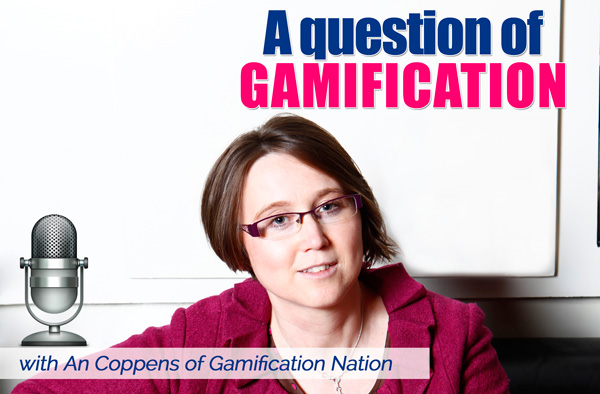Welcome to a Question of Gamification a podcast where gamification expert An Coppens answers your questions.
Hi, and welcome to this week’s a Question of Gamification. This is An Coppens your show host, and also the chief Game Changer at Gamification Nation. This week’s question is, how can you get started with gamification?
Now, for me, that’s a double question in one. For some people that means how can I get started for building a career in gamification? And on the other side is how can I get started and put gamification into practice for my organisation? So those are very frequently asked questions we come across. So to tackle the first one, how can we get started in a career in gamification? Well, the first thing I would say is to look to become an intern.
Ask organisations like my own, and see if you can, first of all, translate an existing regular game into something that can be used for businesses. That’s typically how I asked interns to apply for positions within Gamification Nation. The other thing to do is to start reading up and start following the main people that have shaped the nature and landscape of gamification.
More and more degrees and master’s programs offer and include an element of gamification. So if you are studying game design, that is for sure, fantastic grounding, and look for those organizations or those Institute’s and universities that offer gamification as modules, as part of masters, or degree programs. I know in the UK, there’s a number of universities, like for example, Coventry University has some elements of gamification and game design as part of Surrey University, Birmingham, there’s a number of them. So do your research and find out from those of us working in the industry, how did they get to where they are now?
So to share my career track into gamification, so first of all, I always wanted to be a game designer. So as a kid, I was really obsessed with puzzles and crosswords and was making games from when I was the age of seven or eight years old. And so if you have that passion, then you probably have a good inclination that it might be something you want to do. Then look for a career in game design. My parents told me at the time, and this is many, many moons ago, that game design was not for girls and there was no career initially, you know, you better get a real job. So I guess I took a normal degree. I studied international marketing and I also added a degree or an MBA in change management to it. And then only in the last 15 years did I add a diploma in game design, and I studied everybody that was a somebody in the early 2000s, 2010’s.
So, at that time, Gabe Zicherman was a key speaker, and I think a lot of his work in terms of books ond courses. He had a number of courses on Udemy, were excellent, and I would still recommend that you visit them. The other person I studied and read most of the works from was Mario Herger. And he had a course called Enterprise Gamification on Udemy. So another one that I pretty much absorbed. And then Yukai Chou, who I mentioned in last week’s question of the week, who I did always level one, two, and three, Octalysis framework certifications with and then I read extensively all the books of the likes of Andrzej Marczewski research that came out and at the time, the biggest research was coming out of Canada and the `work from Lennart Nacke and Gustavo Tondello. I quite like and I still follow both guys. I’ve had the pleasure of meeting everyone at the stage of the various organizations and often spoken on the same stages, the Coursera course by Kevin Werbach. I mentioned that last week. Also useful materials. In terms of the learning space, a number of people to mention are Karl Kapp and he has courses on LinkedIn. And he also has a number of books on gamification and on Game Design and simulations. I highly recommend his field book in gamification is probably the best and most grounding book for anyone in the learning space. Also look up Zsolt Olah, who has written extensively about gamification, and has a book out there, obviously, Monica Cornetti and Professor game, or Rob Alvarez, who do a lot of work. And I also followed the talks and work of Sylvester Arnab, who’s a professor at Coventry University. So there are many, many people. So at this stage, if you can’t find works about gamification to get yourself into the spirit of how it works, and what it does, you must be living under a rock or not searching very well. So that’s the first thing I will say. So follow all of those. I highly recommend doing a grounding course in game design, because the game design principles will actually make you a better gamification designer.
So because it is the area that we borrow the most from, I also feel it was beneficial to me to add that to the mix of skills that I had? And then how do you get it to work in practice? Well, what you need in the first place is imagination and creativity. After that, pens paper, post it, and a whole bunch of stickers, which you can probably pick up in any stationery shop, tools that primary schools and preschool teachers use, I often find very useful to get started and get creative with people on gamification design. So you don’t need to invest in large amounts of materials, but I actually do recommend that you invest in some core tools that you like to work with. The things I have, obviously I created my gamification design card decks, I use them a lot in workshops with clients to get people started, the problem I had, and the reason why I designed the cards was because
People were asking you, I want to make a game, but I don’t like games, I don’t play games. So it was bringing people together on the same sort of level playing field. So, as a tool, I carried them around for all of my clients, and I sell a lot of them through the website and at workshops. Now, what constitutes a good game? Well, it needs a game type. So, a good gamification concept starts with some kind of concept, an idea of what it is you want to achieve. And in order to achieve that, you can link a game type to it. A game type can be a puzzle, it can be a challenge. It can be a first-person shooter, it can be a multiplayer game. So you decide what it is it can be an adventure, so there’s plenty of choices. The other thing you need is a number of rules. First of all rules on how you can win or lose the game.
So you need obviously an objective, or how can you win and what it is they need to do in order to win and achieve the win condition. So once you have a win condition, and some rules, you effectively have enough to call it a game. Now typically, most games have some more than that in terms of game mechanics. My theory on it is that the game mechanics that you introduce, create a game dynamics that you might want to find or you may not want to find. So for example, the game mechanic of a leaderboard, by default introduces competition, that is, or is maybe not something you may want to introduce in your workplace. The game mechanic of likes and emojis gives you an element of empathy and elements of sharing but also an element of peer recognition or peer pressure. Because if you think about the social media platforms that use likes and emojis, a lot of people post things in order to get recognized by friends and to get that feel good factor. So you also introduce that.
In my view, gamification is probably 80% psychology and 20% actual mechanics. There are many people that say, Oh, it’s all about the game mechanics. Well, you know, I would challenge that. I would actually say it’s much more than that. It’s about understanding your audience. It’s about understanding how people relate well to your content. It’s about understanding what do people actually want to get from your material? How do you want them to engage with your company? What do you want them to do? So it’s about much more than that. So starting point for gamification for any project to me is always understand your users and set clear objectives. And then yes, then, you can go and start adding rules, game mechanics into play and see how it plays out.
In our processes, we tend to refer back and forth to our user base and you know, the intended target audience to see, okay, are we on the right track? If we put this in, does that speak to you? Or does it not? If it doesn’t, then obviously, we need to make sure that you know, we adopted and that we might take it out. We can also sometimes make the judgment call, Well, look, let’s keep a certain game mechanic or a certain game dynamic, and see how it plays out and what kind of behaviour it triggers. Because sometimes what we well intended for good reasons may play out in a bad way. For example, in a sales related gamification process, we have people trying to game the system. And the rules that we laid out were well taught of rules, but people started to create a workaround so they could actually gain the system. And we needed to have multiple ways of evaluating as opposed to just one single way of evaluation performance any given month or week.
So know that there are gamers in every organization and you’re very likely to come across them. So testing, looking at the data that comes out of your systems, and looking at what do people actually do when presented with the game mechanics that you have? Do they actually respond as intended, or have they got some other response to it, which you may not have anticipated, which is over and above what you expected, or totally the opposite of what you wanted to create. So you want to watch out for all of that.
The best way to do that is to let people loose on your system, whether that’s paper-based and I always, always recommend start with paper, develop everything on paper and then graduate into digital. It will save you a lot of money later on if you’ve tested on paper first. testing on paper is great fun in workshops and gives lots of good input, new ideas, etc. So don’t overlook it. Unless you have, of course, have unlimited pockets and an unlimited budget, in which case, feel free to go ahead and hire really expensive developers and designers and get a bespoke project on. But our recommended methods are paper first. Once proven on paper, let’s go digital, and then digitally track what people do observe, look at data reports that come back to you.
Most gamification platforms on the market today will allow you to see data analytics, sometimes you may need to make sense out of them. So you mean may need to create custom reports for them to actually make sense to your yourself but also to the people that need to co-evaluate with you. To be clear on what it is that you want to find out which of the things you want to track, and then set it up accordingly. So how do you get started beyond that in big organizations? I always recommend, find one group, one pilot project, one pilot team that you can start with, when you have proven that it works for one team then gradually move out farther, I wouldn’t be a big fan of rolling a big project out to everyone in one go. Because it’s very hard to control. And it’s very hard to get right in that case. And if you then need to make changes, you actually do often upset a lot of the users who have to reuse and unlearn and relearn behaviours or newer tools, which typically they don’t like and, you know, don’t find fun, so you’ll get a lot of negative feedback. So other than that, go for it. Have fun.
Our cheapest of game designs today in the or two days in the working world in the corporate sector is has been done with a whiteboard and a whiteboard marker. So that’s the cheapest we have been able to do it. So if that’s the kind of budget you have, be creative with what you have. You don’t have to have big budgets to get things done. You can start on a small budget, if you want to have something digital, there are very cost effective solutions out there. And some of the bigger platforms will allow you to start let’s say one month free of charge or one-month trials, which then allow you to test whether it will work for a group or not. But what I would recommend there is that still do it on paper first and then graduate into putting it on your website, putting it on to an app or whichever form or platform you decide to use. Tests on paper, start on paper, read, have fun, play games.
Games are the highest form of research, or that’s what Einstein said. And you know, can’t argue with a smart man like this. So I hope you like this version or this week’s question of gamification. It is a bit of a build up from last week. So there is a little bit of crossover. And if you’ve listened last week, you might recognize one or two items. Last week, it was about keeping up to date this week, it’s about getting started. So I hope I’ve given you a little bit of a different slant. And if you like our episodes, please do rate them on the platform that you listen, it gives us a bit of a boost in our rankings. So we always like that. And if you think there are people that may want to hear this, do share it forward to your friends and family and colleagues and whoever you think could benefit. I love talking to you and I hope to hear from you soon. Put your questions in our comments on our blog and we’ll aim to answer them in our next sessions of a Question of Gamification.




